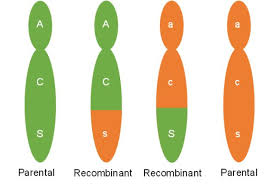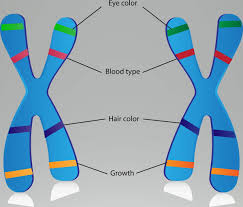In this article, traits that deviate from the simple dominant/recessive relationship are examined. The inheritance patterns of these traits still obey Mendelian laws. However, they are more complex and interesting than Mendel initially realized.
Mendelian inheritance describes inheritance patterns that follow two laws: the Law of Segregation and the Law of Independent Assortment, as discussed in the previous module.
Read Also: The Yams Pistil: Economic Importance, Uses, and By-Products
Deviations from Mendelian Inheritance

Non-Mendelian inheritance, also known as exceptions or deviations from Mendelian laws, refers to any pattern of inheritance in which traits do not segregate in accordance with Mendel’s laws. Several circumstances appear to contradict Mendel’s Laws.
1. Incomplete Dominance: This occurs when the heterozygous phenotype is intermediate between the two homozygous phenotypes. It is a form of intermediate inheritance where one allele for a specific trait is not dominant over the other. There are two types of incomplete dominance: co-dominance and over-dominance.
2. Co-dominance: An example of this is the four-o’clock plants, which may have red, white, or pink flowers (Fig. 22). Plants with red flowers have two copies of the dominant allele (RR), while plants with white flowers have two copies of the recessive allele (ww).
Pink flowers result from plants with one copy of each allele (RW), where each allele contributes to a blending of colors.
The ABO blood system in humans is another example of co-dominance. Heterozygote IA/IB individuals have blood group AB because both the A antigen (from the IA allele) and the B antigen (from the IB allele) are produced. Thus, the IA and IB alleles are co-dominant.
3. Overdominance: This type of incomplete dominance occurs when the heterozygote performs more extremely than both homozygotes. An example is sickle cell anemia, an autosomal recessive disorder where affected individuals produce an abnormal form of hemoglobin.
The sickle cell trait exhibits a form of overdominance as heterozygotes have more beneficial traits than homozygotes.
Another example can be seen in the white Wyandotte breed of poultry. The gene for the Rose comb (R) is dominant to the gene for a single comb (r). Heterozygous males have normal fertility, while homozygous dominant males have reduced fertility.
| Genotype | Phenotype | Male Fertility |
|---|---|---|
| RR (Rose comb) | Rose comb | Lower fertility |
| Rr (Rose comb) | Rose comb | Normal fertility |
| rr (Single comb) | Single comb | Normal fertility |
4. Multiple Alleles: A trait controlled by more than two alleles is said to be controlled by multiple alleles. Traits controlled by multiple alleles produce more than three phenotypes of that trait. For example, the blood group in humans is controlled by an autosomal gene locus I, which has alleles A, B, and O.
The O allele is recessive to both the A and B alleles. A person with the genotype IA/IB has the blood type AB because both alleles are expressed.
5. Incomplete Penetrance: This refers to a dominant allele that does not always express itself in the phenotype of an individual. A good example is polydactylism, an autosomal dominant trait where individuals have additional fingers or toes. A single copy of the allele is usually enough to cause the condition, but some individuals who carry the dominant allele do not exhibit the trait.
6. Variable Expressivity: This refers to the degree to which a trait is expressed. In the case of polydactylism, the number of extra digits can vary. Some individuals may have many extra digits, while others may have just one extra digit.
The molecular mechanisms behind variable expressivity and incomplete penetrance may not always be fully understood, as the range of phenotypes can be influenced by environmental factors and other genes.
Read Also: The Soybean Epicotyl: Economic Importance, Uses, and By-Products
Deviations from Mendelian Inheritance

This phase discusses additional deviations to Mendelian laws, further expanding on different types of gene actions.
1. Sex-Limited Traits: These are autosomal genes (genes located on non-sex chromosomes) that affect traits that only appear in one sex. Examples include milk production in dairy cattle, breast development in humans, and egg production in chickens.
The genes responsible for these traits operate in females but not in males. For example, feather plumage in chickens depends on the production of sex hormones. If the ovary is surgically removed from a newly hatched female, she will develop cock-like feathering.
Inheritance of sex-limited traits can be illustrated in chickens, where hen-feathering is determined by the interaction of the h gene. Female chickens with the genotype h+/h+ or h+/h will show hen-feathering, while males with the h/h genotype exhibit cock-feathering.
2. Sex-Influenced Traits: These are autosomal traits that appear in both sexes, but either the frequency or the relationship between genotype and phenotype differs. An example is pattern baldness in humans, where the genotype Bb causes baldness in males but does not in females.
Inheritance of baldness in humans.
| Genotype | Male Phenotype | Female Phenotype |
|---|---|---|
| BB | Bald | Bald |
| Bb | Bald | Non-bald |
| bb | Non-bald | Non-bald |
3. Sex-Linked Traits: These traits are located on the sex chromosomes and exhibit different inheritance patterns compared to autosomal traits. Males have one X and one Y chromosome, while females have two X chromosomes.
If a male carries a recessive allele for a disorder like hemophilia or muscular dystrophy on his X chromosome, he will express the condition, as there is no second X chromosome to mask the effect. Red-green color blindness is another example of a sex-linked trait.
4. Lethal Genes: These are alleles that cause the death of an organism. If the mutation is caused by a dominant lethal allele, both heterozygotes and homozygotes show the lethal phenotype. If the mutation is recessive, only homozygotes will exhibit the lethal phenotype.
In chickens, an embryo containing two copies of the recessive “creeper” gene dies within the eggshell. Additionally, the frizzled gene, which causes incomplete feather development, results in high mortality due to heat loss.
Inheritance of Lethal Alleles in Mice:
In mice, yellow fur is controlled by a dominant allele AY, which is lethal in the homozygous state. When yellow mice are crossed, the offspring exhibit a 2:1 ratio (yellow: non-yellow) due to the death of homozygous AY/AY individuals.
Do you have any questions, suggestions, or contributions? If so, please feel free to use the comment box below to share your thoughts. We also encourage you to kindly share this information with others who might benefit from it. Since we can’t reach everyone at once, we truly appreciate your help in spreading the word. Thank you so much for your support and for sharing!

